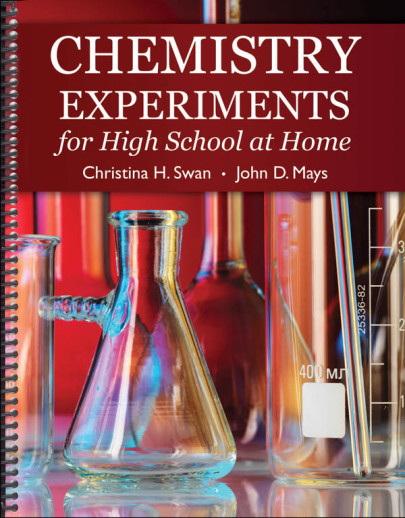We use cookies to make your experience better. To comply with the new e-Privacy directive, we need to ask for your consent to set the cookies. Learn more.
Chemistry Experiments for High School at Home
Chemistry Experiments for High School is written for schools with standard laboratory facilities and equipment and includes detailed information for both teacher and student on lab safety. It also provides instructions for 20 experiments, supply lists, discussion questions and more. Individual experiment instructor notes are found in the back of the book. Each experiment concludes with a short report. Pages are perforated for easy removal. This resource accompanies both the Novare General Chemistry and the Chemistry for Accelerated Students providing references for both texts. The author recommends the optional Student Lab Handbook to accompany the laboratory experiments.
In contexts without a lab facility, conducting effective chemistry experiments is one of the greatest challenges. Homeschooling families may resort to "easy experiments using household items. The result can quickly become little more than a magic show. Students mix ingredients and watch the effects, but are not taught real chemistry. The chemicals, procedures, and equipment often bear little or no resemblance to what a real chemist would use, and they do not prepare students for the rigors of their college science courses.
Novare Science & Math has the goal of helping home educators conduct excellent science education. In the chemistry lab, this means bringing students into the real chemist experience. It requires effort, skill, and patience learning and observing universal safety procedures, use of correct terminology, use of apparatus, skills of measurement, recording, documentation, cleanup and waste disposal. The best educated students will also take some time to learn the background of an experiment, how to analyze results, and how to write a quality lab report.
This book has low-cost alternatives to expensive equipment and recommendations for procuring small quantities of chemicals. Of course, some expenditure on basic equipment is required, but for all 20 experiments the cost is less than $200.
Each experiment includes Learning Objectives, Lab Skills Focus, Materials and Apparatus List, safety issues, Background, Procedure, as well as any special waste disposal matters. Pages are perforated so that students can remove the Short Form Report Sheets for each experiment. The book is intended for each student to have their own copy.
Experiments:
- 1.Measurement of Physical Properties
- 2.Separation of Components in a Mixture
- 3.Flame Texts and Metal Cation Identification
- 4.Determining the Empirical Formula of a Copper Chloride Hydrate
- 5.Activity Series
- 6.Limiting Reactant and Percent Yield
- 7.Intermolecular Forces
- 8.Molarity
- 9.Mole Amount of Gas
- 10.Metathesis Reactions
- 11.Acid-Base Titration
- 12.Effectiveness of Antacids
- 13.Calorimetry and Hess' Law
- 14.Rate Law Determination for the Acid-Catalyzed Iodination of Acetone
- 15.Titration Curves and Ka
- 16.Determination of the Percentage of Iron in Iron SupplementsRedox Titration
- 17.Electrochemical Series
- 18.Synthesis of Aspirin
- 19.Calorimetry of Organic Compounds
Intended for use at the 11th grade level, this mastery-based chemistry course takes a bit of a different approach from other chemistry courses. Focusing on fewer topics with more depth, Novare Science takes a Kingdom Perspective to current scientific theories. Prior to the course, students should have successfully completed Algebra 1, Introductory Physics and Biology. Algebra 2 should be taken concurrently. By following the author's suggestion of physics first, the student can more easily work through General Chemistry and have a greater understanding of the concepts. Through General Chemistry, students are brought into the real world of chemistry through detailed and clearly explained text, laboratory experiments, and carefully constructed exercises and quizzes. The history of modern chemistry, mathematics and technical communication is emphasized throughout. Typically, you need a lab component with chemistry courses. No labs are included in the Student Text, so the author recommends Chemistry Experiments for High School at Home for those who are homeschooling. This book has low-cost alternatives to expensive equipment and recommendations for procuring small quantities of chemicals. Optional and helpful resources include the Student Lab Report Handbook and the optional Lab Kit. Required components include the Student Edition Text, Digital Resources, Complete Solutions and Answers, and the Chemistry Experiments for High School at Home to meet the lab requirements on your high school transcript. Available separately or as a convenient package for the full Program.
| Product Format: | Paperback |
|---|---|
| Grades: | 11-12 |
| Brand: | Novare Science and Math |
| Author: | Christina H. Swan and John D. |
| ISBN: | 9780990439776 |
| Length in Inches: | 11 |
| Width in Inches: | 9 |
| Height in Inches: | 0.75 |
| Weight in Pounds: | 1.25 |


My teen needs it for home school co-op
Virtual high school chemistry class during the pandemic does not include lab work.
Recommended by a friend.
My 8th grader is intrigued with Chemistry and I want to broaden her horizons on the subject. She will learn basic chemistry projects with this book,